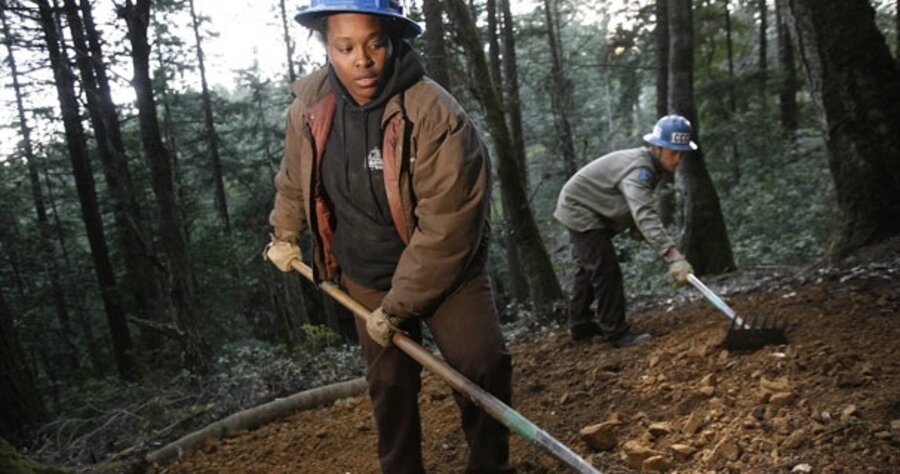US economic crisis puts youth corps at risk
Loading...
| Mt. Tamalpais, Calif.
It’s a tough job market, especially for a young man living on the streets. But 23-year-old Cory O’Malley found work five months ago with the California Conservation Corps (CCC). It’s put a roof over his head, the sweat of hard labor on his back, and a certain twinkle in his eyes.
The twinkle comes from Desiree, his fiancée whom he met in the corps, and plans for a brighter future through job training and college. He credits the CCC with turning his life around.
“Even my parents noticed when I went down to see them at Christmas. They were like, ‘You are so helpful.... You are changed, changed for the good,’ ” says Mr. O’Malley, covered with sweat and dirt from building forest trails north of San Francisco.
O’Malley epitomizes what the CCC was designed to do – turn around at-risk youth through work and training. But the CCC and similar programs in other cash-strapped states are now facing massive cuts. California’s budget situation is so dire that the governor has proposed terminating the state program entirely.
The story is reversed at the federal level, where the incoming administration of Barack Obama has expressed interest in expanding job corps. Some of the debates over the CCC might soon echo in Washington – namely the desire to provide jobs and training in an economic crisis, versus questions of program efficiency and effectiveness.
Combining work and service
The timing couldn’t be worse for eliminating the CCC, says Barbara O’Connor, a member of its board and a communications professor at California State University (CSU) in Sacramento. “At CSU, young males are dropping out like flies. It’s a national disaster and we better find places to train these young people for green jobs or something.”
Some 26,000 young people are involved nationwide under the umbrella of The Corps Network. The group represents 136 corps operating in 42 states and the District of Columbia.
Many, like the CCC, are geared toward environmental projects and disaster response; others do community projects in education and human services. The programs have their roots in the Depression-era efforts to put the nation back to work, while adding a modern component of apprenticeship and continuing education.
“Virtually all the corps we represent are being challenged financially at this point in time,” says Sally Prouty, president and CEO of the The Corps Network. Funding comes from foundations and corporations, federal sources like AmeriCorps, and state and local grants. “Every one of those areas of funding is being cut back,” Ms. Prouty says, “So we are advocating federal funding for the purpose of supporting corps nationwide.”
Her group is also tapping into the public works zeitgeist, calling for the creation of a clean-energy service corps, a transportation corps, and a native American corps. A white paper by several influential groups puts the cost at $1.25 billion over five years to hire and train 125,000 young people to do energy efficiency retrofitting.
The recommendations seem to resonate with the new administration’s thinking. Mr. Obama’s transition website outlines plans to expand AmeriCorps from 75,000 slots to 250,000, a doubling of the Peace Corps, and the creation of an “energy-focused youth jobs program.”
Efficiency questions
Critics point out such programs have proven inefficient in the past. “This is the type of thing that is driven by trying to make work and having the appearance of people doing good things,” says James Bovard, who has written critical assessments of AmeriCorps. “The history of AmeriCorps shows that it just results in a lot of photo ops and not achieving very much.”
Neither was the General Accounting Office glowing in its assessments in the 1990s of the Department of Labor’s Job Corps program. It spent a lot on youth who didn’t stay long enough to complete training, and upon exit, often wound up working low-skilled jobs, the GAO found.
More recent data from Job Corps suggests that roughly half get a GED while enrolled, and three-quarters go on to jobs or higher education.
Other research points to successes. After participating, black males were one-third less likely to be arrested and 50 percent more likely to be employed, according to a 1997 study by Abt Associates, Inc.
In California, the governor’s representatives don’t dispute that the CCC does good work, including repairing back-country trails, working fire lines, and cleaning up after disasters. But they argue that the state can’t afford to spend $34 million on the program when it has a $42 billion deficit.
Gov. Arnold Schwarzenegger’s budget would phase out the CCC over three years. Some new money would be put into local California corps instead, with greater emphasis on training. “The corps, when it first started, was a balance between training, education, and work experience. What it’s evolved into is work experience and not enough training and education,” says Sandy Cooney, spokesman for the state Natural Resources Agency.
CCC officials deny that: Every participant without a high school diploma must do schooling after work, and the program has connected youth to jobs with unions, fire agencies, and the state parks.
Mr. Cooney also notes the CCC spends about $40,000 of state funds per participant – enough, he says, to hire a fire crewman or a park ranger.
That cost, counters CCC’s O’Connor, includes room and board, and overhead costs. “We train kids to get jobs who we would have to support on welfare and in prisons. You can’t compare the two.”





